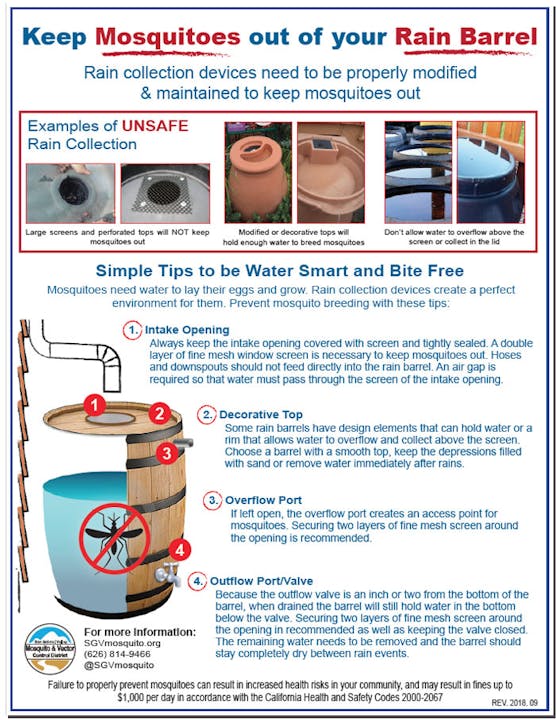Mosquitoes Love Rain Barrels

Collecting rain water is a noble effort, but it’s also a lot more work than most people think. Throwing a rain barrel in the back yard to catch the rain is only the beginning. Holding the water safely and using it quickly can be difficult; and the upkeep and regular inspection required takes a real commitment. If not maintained properly a rain barrel can become a mosquito factory very quickly.
The challenge, is that there is no rain barrel on the market today that is completely mosquito proof. Whether you buy a rain barrel from a garden store or make your own device, every system will require specific modification, maintenance, and regular inspection to keep mosquitoes from growing inside. Mosquitoes need standing water to grow and rain barrels create the perfect environment for them. The key is to keep adult mosquitoes from getting inside to lay their eggs. Here are some tips to keep your rain barrel mosquito free.

1. Intake Opening: Always keep the intake opening covered with screen and tightly sealed. A double layer of fine mesh window screen is necessary to keep mosquitoes out. Hoses and downspouts should not feed directly into the rain barrel. An air gap is required so that water must pass through the screen of the intake opening.
2. Decorative Top: Some rain barrels have design elements that can hold water or a rim that allows water to overflow and collect above the screen. Choose a barrel with a smooth top, keep the depressions filled with sand, or remove water immediately after rain events.
3. Overflow Port: This opening helps keep water from filling above the intake screen, but if left open, creates an access point for mosquitoes. Securing two layers of fine mesh screen around the opening is recommended.
4. BTI: Bacillus thuringiensis israelensis is natural bacteria used to kill off mosquito larvae. These larvicides specifically target mosquito larvae and do not cause harm to pets, fish or humans. They can be purchased at your local home and garden store and must be used to prevent the development of mosquitoes.
5. Outflow Valve: Because the outflow valve is an inch or two from the bottom of the barrel, some water will always remain in the bottom without special attention. Be sure to tip and empty the barrel completely between rain events. Ensure the valve is closed when not in use and secure with two layers of fine mesh screen around the valve opening to block mosquito access.
Rain barrels are not designed to safely store water for extended periods of time. After a rain event, use the water as soon as possible and keep your rain barrel completely dry until it rains again. For more information please contact your local vector control agency.

That’s right! Mosquitoes need standing water to lay their eggs and grow. Any container that holds more than a teaspoon of water and left uncovered for more than a few days can grow mosquitoes. Here’s what the life cycle looks like.

Egg: The female mosquito finds a suitable place to lay her eggs. She can lay eggs in rafts of 100-300 (shown here) on the surface of standing water or individually along the containers inside edge, depending upon her species.
Larva: Within days, larvae hatch from the eggs. Mosquito larvae are often found at the surface of the water where they breathe air and feed on algae and bacteria. They shed their skin four times as they grow over several days.
Pupa: In the next stage of the life cycle, mosquitoes morph into pupae where they will finish their development in a cocoon-like shell. Pupae do not feed but must come to the water surface to breathe. Once fully developed, the pupal skin splits and the adult mosquito emerges.
Adult: Newly emerged adult mosquitoes rest on the surface of the water until they are strong enough to fly. After mating, female mosquitoes fly off in search of a blood meal necessary for developing eggs and start this process all over again.
It only takes 5-7 days for mosquitoes to go from egg to biting adult!

